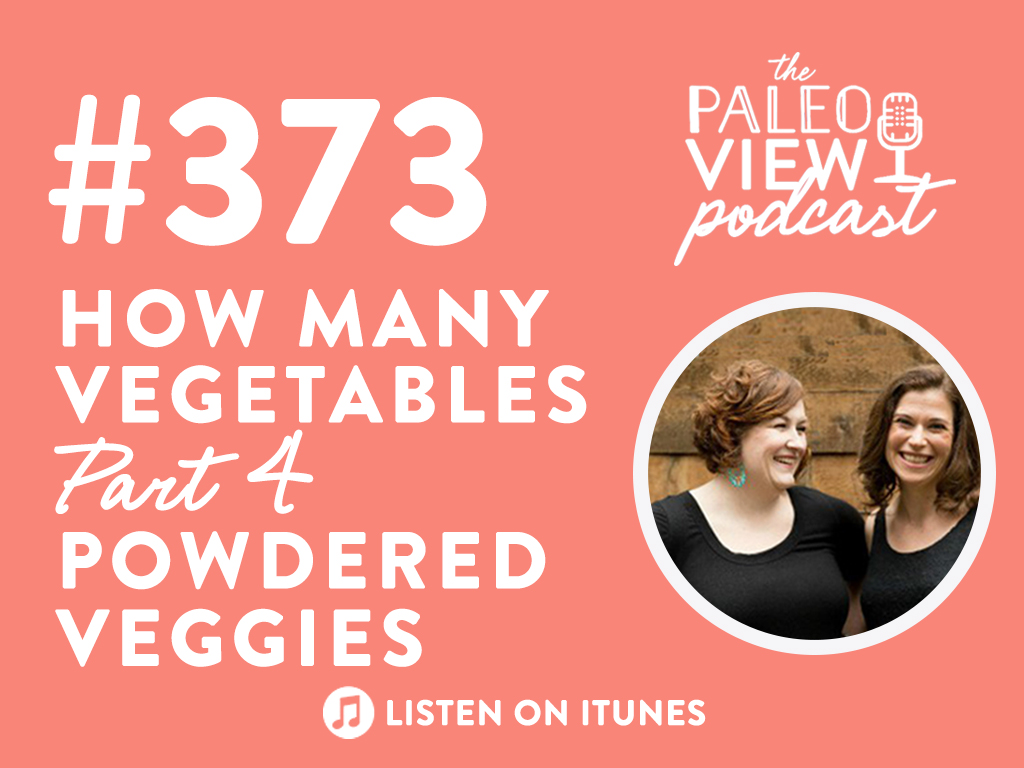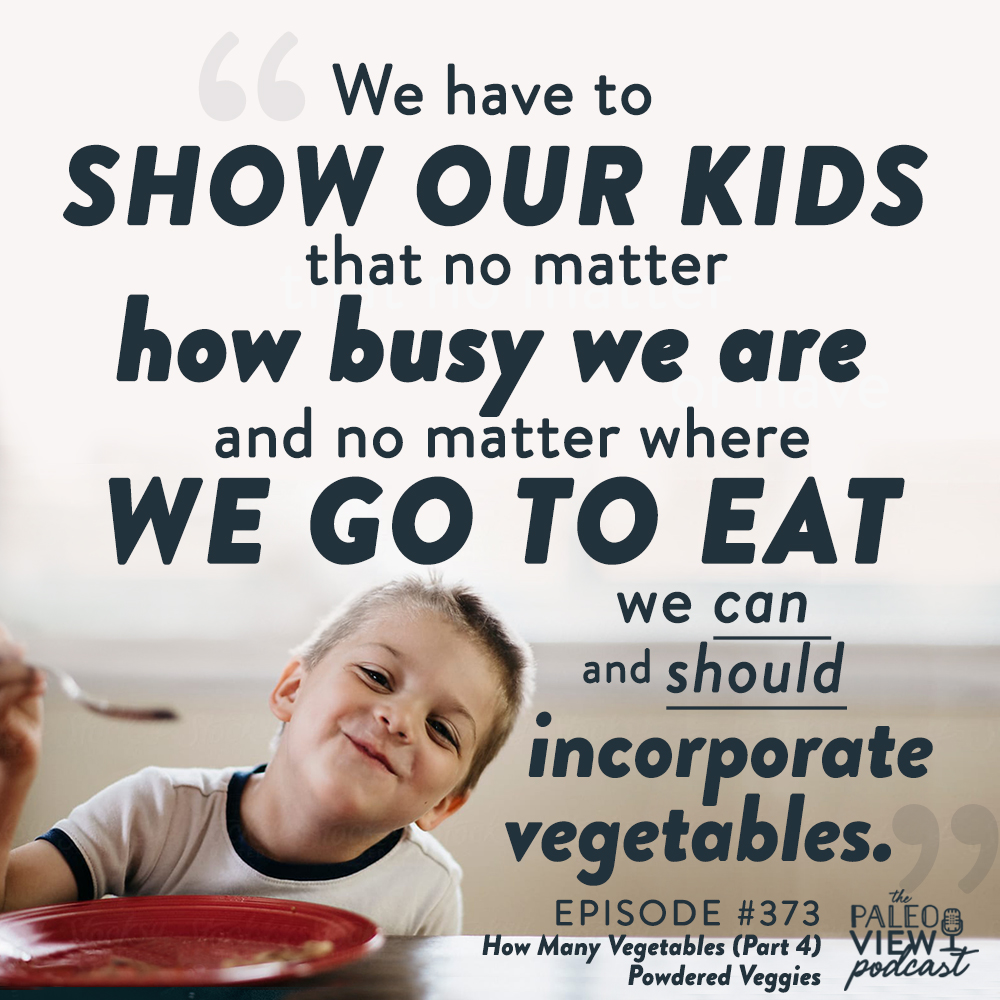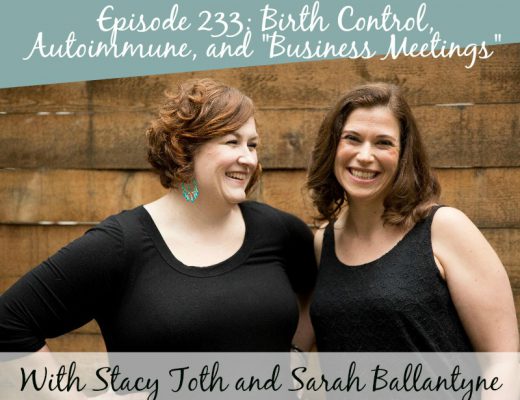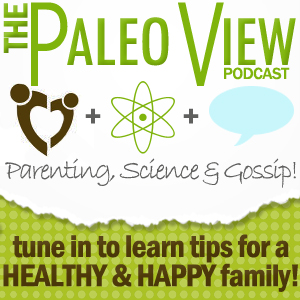
On this week’s episode, Sarah and Stacy continue the ‘How Many Vegetables’ podcast series and address a listener’s question about powdered veggies. Does this supplement pack as many nutrients and benefits as the labels claim? Can powdered fruits and veggies help us hit our health goals? All of this and more in episode 373. Enjoy!
If you enjoy the show, please review it on iTunes!
The Paleo View (TPV), Episode 373: How Many Vegetables (Part 4) Powdered Veggies
Welcome back to the Paleo View listeners – episode 373! (0:41)
Sarah has 98% of her voice back, and it is almost all the way better.
Stacy is into powdered vegetables.
It is interesting to Sarah that they have done 10 to 15 episodes tackling vegetables from different perspectives.
This episode is part of the ‘how many vegetables’ series, where Stacy and Sarah explain the reasons behind a high vegetable consumption diet.
Stacy corrected Sarah and noted that they have likely discussed a high vegetable diet for 373 episodes.
Sarah has always thought of powdered veggies as a wholefood supplement to make a high veggie diet doable.
Before the hosts dive into the meat of the show; this week’s episode is sponsored by Joovv.
Red and infrared light therapy can benefit just about every system in the human body.
For Stacy and Sarah in particular, Joovv red light therapy has helped reduce inflammation, regulate the immune system, reduce pain, improve thyroid health, improve sleep quality and more.
You can learn more by visiting this link here.
Stacy wanted to remind listeners, that Joovv does offer different sizes with various price points. Check them out!
Powdered Fruits & Veggies
Listener Riley listened to the ‘how many vegetables’ series and had a follow-up question in reference to the celery juice episode. (9:03)
Riley asks, “what about the OPPOSITE of juicing?
So many people are starting to offer these powdered greens, mushrooms, fruits, etc. to pack in nutrients.
When Sarah was talking about the nutrients, fiber, and phytochemicals that get lost in the juicing process, it made me wonder if any of those are lost in the drying/ powdering process, as well?”
Stacy wanted to take a moment to remind listeners that the point of vegetables is that they are full of health benefits.
If the only way we are consuming vegetables is by “sneaking them” then we are not teaching how important these vegetables are for health long-term.
There are things that we can do to help kids build up their taste for vegetables.
However, as adults, we need to eat vegetables and show our kids we are eating vegetables.
We have to show our kids that no matter how busy we are and no matter where we go to eat, we can and should incorporate vegetables.
Stacy wanted to lay this groundwork before they discuss powders and juicing.
Sarah wants to remind listeners of the key message here. (15:45)
High vegetable consumption is fundamental for longterm health.
The most sustainable and affordable way to achieve that is not by relying on supplements.
Sarah is not an anti-supplement person, but she doesn’t think they are our first line.
Supplements are a fine-tuning tool.
When we are using supplements to replace something we are having a hard time consuming as part of our diet, we need to ask ourselves why.
Sarah thinks there is a healthy balance where we are making an effort to eat as many fresh vegetables as we can and teaching that behavior to our children.
The Dehydration & Grinding Process
There are two different classes of methods when it comes to dehydrating vegetables. (18:52)
One is with heat and one is with refrigeration, and there are various technologies within these two categories.
The temperatures used with the heat method varies but is typically between 60 and 80 degrees Celcius.
With some methods, the temperature gets so high that the vegetables are being cooked during the dehydration process.
Opposite to the heat methods is basically freeze-drying.
With the heat-based dehydration methods, you are losing nutrients.
It is not as bad as some people think, but it varies by the food, the exact process, and the nutrient that you are looking to measure.
One paper, in particular, was looking at fresh soups versus dry powder mixes that were then mixed to make a soup and the difference in nutrient retention.
This study was looking at the nutrients in the tomato, pumpkin, and onion.
They also used a nutrient density score in this test, measuring the fiber content, magnesium, iron, zinc, potassium, vitamin A, vitamin B1, vitamin B2, vitamin B3, vitamin B6, vitamin C, and vitamin K1.
The dried and powdered tomato only had 67% of the equivalent of the fresh tomato. So it lost 1/3 of its nutrients in the dehydration process.
The onion had 95% compared to fresh.
The pumpkin had 93% compared to fresh.
Certain nutrients are more volatile than others.
This shows you that it is really hard to make a blanket statement regarding the change in nutrients when converting fresh vegetables to powder form.
Vegetables offer us fiber that is important to our gut microbiome, important vitamins and minerals, and antioxidant phytochemicals.
When you start to look at antioxidant phytochemicals, this is where heat drying methods start to seem unsatisfactory.
Studies have shown that in hot air drying methods, the powder can have as little as three percent of the flavonoid content as the starting fresh food.
It seems as though, the higher the temperature of the drying process, the lower the nutrient content is of the end product.
Look for labels that include the words raw and/or low temperature.
Minerals tend to not be lost in this process, but vitamins and phytochemicals are.
It depends on how you are measuring nutrient loss, the exact food, and the exact dehydrating and powdering process.
Most of the typical grinding techniques to make a vegetable powder also cause loss of nutrients. (26:23)
The normal methods for grinding after convection dehydration, or hot air drying, would add mechanical heat.
There have been various studies looking at what happens additionally to nutrients after the food has been dehydrated when it is ground.
It is shown that there can be an additional loss of volatile compounds by 30%, and also lose most of the flavonoids.
Looking at high antioxidant fruit powders, studies showed that by the time you dehydrate those and use mechanical grinding, the finished product has no antioxidant capacity.
There are some processes where they pre-chill the food, pre-cool the equipment, or they add some coolant to the process to keep the food from getting too hot.
This process will help to reduce nutrient loss.
Overall, this is a challenge for the food industry, as there is a market for vegetable powders.
However, through the standard inexpensive ways of creating them, you can lose some of the most compelling nutrients that are in the food that makes it a healthy food.
The Nutrient-Density Factor
With the freeze-drying technique, this process is done with very cold temperatures, in a vacuum. So it is done in the absence of oxygen.
Freeze drying is fantastic for retaining color, shape, aroma, flavor profile, and nutritional value.
There are some foods that are more susceptible to nutrient loss even under freeze-drying conditions.
However, when you are looking at a food that is more susceptible to nutrient loss, you are looking at a 10 to 20% compared to 97% loss of nutrients.
Most of the studies have shown that nutrient loss is more in the 5% range.
So you are retaining more of the vitamin C, antioxidant phytochemicals, and a lot more of the other vitamins.
There has been a huge variety of studies that looked at fruit and vegetable freeze-drying.
These studies showed that freeze-drying is the best method for nutrient and phytochemical content retention.
Stacy remembered that NASA freeze-dries the astronauts’ food. (33:27)
NASA clearly has this figured out.
There are studies showing that freeze-drying can even increase phytochemicals.
Consuming something freeze-dried is pretty close to equivalent to consuming fresh food.
To maintain the nutrients, this means that the freeze-drying needs to be combined with a grinding technique that keeps the powder cold.
There are two grinding techniques that are typically used with freeze-dried foods.
In scientific details, Sarah described more about how the dehydration process works versus the freeze-drying process.
Powdered Vegetables & Fruits Role on Health
There have been some studies looking at powdered vegetable supplements and shown some health benefits. (40:34)
There was a four-week study in ten people where they were given two tablespoons of a greens powder.
The results showed that the powder improved their antioxidant capacity and reduced oxidized proteins and oxidized lipids in the blood.
There was a ninety-day study in forty people with high blood pressure, who were given two tablespoons of a greens powder daily.
They showed a reduction in blood pressure over three months.
However, you see the same effects in studies when you just give them more vegetables.
It is nice to see that a powdered vegetable supplement can show measurable health effects. However, there is nothing special about powdered vegetables.
It is worth discussing though, that there is one potential exception.
And this is the effect of a smaller fiber particle size on the microbiome.
This is relevant to a vegetable or fruit powder but is also relevant to making a smoothie or soup in a high powered blender.
Different foods are fermented faster at a small particle size, and others ferment faster at large particle sizes.
The details of fiber structure matter.
The detail of the molecular structure matters in terms of what types of bacteria can access it, how easily they can access it, and how easily they can use it as food.
This is why a high variety of vegetables is really important for supporting a healthy and diverse gut microbiome.
Additionally, this is why we want to mix up consuming both raw and cooked vegetables.
When it comes to the gut microbiome there is not a concise statement that can be made regarding powdered vegetables.
We ideally need to consume a mix of fibers; some that ferment slowly and some that ferment quickly. This is so that fiber can be digested throughout the digestive tract.
In Summary
There is nothing wrong with powdered fruit and veggies from a gut microbiome perspective. In fact, there are times when they might be beneficial.
There is not an argument to be made in favor of powdered fruits and vegetables from a gut microbiome perspective.
So whether we look at it from a nutrient perspective or a gut microbiome perspective, we are basically seeing the same thing.
Freeze-dried retains nutrients and that there is nothing about vegetable powders that makes them a compelling substitute for fresh fruits and vegetables.
The only caveat is how powders can fit into our lives with ease and convenience.
Stacy adds powdered veggies to smoothies, using the blend Sarah helped create with Vital Proteins.
It isn’t something Stacy has every day. However, she finds that it is a great way to get in veggies when she isn’t in the mood to eat a meal.
With her meals, Stacy is always looking for ways to add micronutrients with her macronutrients.
Stacy shared more on her go-to smoothie recipe.
The Vital Proteins collagen veggie blend is AIP. Two small scoops have a serving of collagen peptides, two servings of vegetables and half a serving of high antioxidant fruit.
This specific blend has eleven fruits and vegetables in it.
The amount of freeze-dried vegetable powder that you have to consume to equate to a serving can vary dramatically from company to company.
Using the fiber grams and calories, you can compare how much of the powder you need to get to equal to how much fresh.
Sarah did a bit of research on various brands of powdered vegetables, looking at the cost and serving comparison of powdered versus fresh produce.
The goal here is to consume more fruits and vegetables and to make behavioral changes in our life that support lifelong health.
We need to evaluate what is our challenge to consuming more fresh vegetables.
When people have a lot of GI symptoms when they consume a lot of vegetables, often vegetable powders can be a lot easier on the digestive tract.
In this particular example, powdered vegetables can be an entry point into consuming more fresh fruits and vegetables for people who are recovering from GI conditions.
Look for a powder that has been freeze-dried, or lowest temperature processing possible.
Also, do your own math to find out what the fresh equivalent is. Do not count on the servings on the label to inform you what the fresh servings are.
Work on adding more fruits and vegetables to your diet. And potentially use vegetable powders as a really good tool when/if needed.
Vegetable powders hit most of the pro column checks that Sarah would look for.
Closing Thoughts
Sarah thinks it’s awesome that we have something like vegetable powders available to us. It makes consuming higher amounts of fresh fruits and vegetables easy to fit into busy lives.
Stacy wanted to thank Joovv again for sponsoring this show. (1:01:41)
Sarah and Stacy both use and love Joovv.
Check out this podcast episode for more on how Joovv plays an important role in Stacy and Sarah’s health journey.
And learn more about the Joovv products here: https://joovv.com/paleoview
So drink your collagen veggie blend smoothie while you are using your Joovv and think of how your body is loving it.
Thanks for listening! And of course, Stacy and Sarah will be back again next week! (1:02:43)





